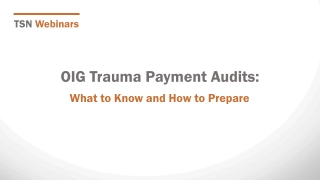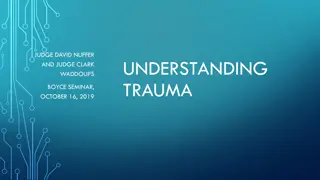Understanding Trauma's Impact on the Brain: A Comprehensive Overview.
This content delves into the neurobiology of trauma, exploring how different brain systems are affected by traumatic experiences. It covers topics such as amygdala hijack, coping skills, and the Polyvagal Theory. A survivor's experience is shared to provide insight into the real impact of trauma on individuals. Strategies for regulating dysregulated systems, like grounding techniques and progressive muscle relaxation, are also discussed.
Download Presentation

Please find below an Image/Link to download the presentation.
The content on the website is provided AS IS for your information and personal use only. It may not be sold, licensed, or shared on other websites without obtaining consent from the author. Download presentation by click this link. If you encounter any issues during the download, it is possible that the publisher has removed the file from their server.
E N D
Presentation Transcript
THE NEUROBIOLOGY OF TRAUMA ANNA LIEBER, M.S., LCMHC & ANNE FARLEY, M.S. ACMHC
OBJECTIVES Identify and understand the biological functions of each system of the brain and how they are impacted by trauma Describe and discuss an amygdala hijack and three coping skills to address regulating this system Understand the Polyvagal Theory and how to increase awareness of warning signs and healthier coping skills
TRAUMA AND THE BRAIN (NHS LANARKSHIRE EVA SERVICES, 2015)
A SURVIVORS EXPERIENCE: Jane, a 22 year old female, living on the east coast, went out with friends to a bar to celebrate a recent promotion. While at the bar, she received a phone call and due to the noise, stepped outside into the alley After finishing her phone call, she turned around to a group of men who physically and sexually assaulted her. Jane reported a bag was placed over her head, she fought with her hands, and shared that she blacked out, but not before having the thought, I am going to die. (R.FARLEY, PERSONAL COMMUNICATION, OCTOBER 22, 2020)
BRAIN SYSTEMS (LUISETTO, MAURO, 2018)
FRONTAL LOBE Thinking Brain Executive Functioning Logical reasoning Analytical (LUMEN LEARNING, N.D.)
AMYGDALA Emotional Brain Stress Scanner Learned Memory Amygdala Hijack KULKARNI, M. (2014). AMYGDALA: A BEAST TO TAME.
AMYGDALA HIJACK TICKOO, D. S. (2021, APRIL 12)
REGULATION OF A DYSREGULATED SYSTEM Grounding Strategies 5-4-3-2-1 + descriptor 4 W s: Orient the individual to who, where, when, and what Progressive Muscle Relaxation Directed Awareness Auditory, visual, touch, movement, breath CLARK, C., CLASSEN, C. C., FOURT, A., & SHETTY, M. (2015). TREATING THE TRAUMA SURVIVOR: AN ESSENTIAL GUIDE TO TRAUMA-INFORMED CARE. ROUTLEDGE/TAYLOR & FRANCIS GROUP., 72-82
HIPPOCAMPUS Memory Center Short & Long Term Memory Storage Sequencing Placing memories and events in sequential order NEUROSCIENTIFICALLY CHALLENGED (N.D.)
MEMORY Not only can the hippocampus not integrate various systems of attention and memory, it also disrupts the storage of information. The hippocampus can disrupt memory encoding for conscious explicit memory when it is blocked or damaged by stress hormones or inhibited by intense amygdala activation. (Cozolino, 2017) NATIONAL INSTITUTE FOR THE CLINICAL APPLICATION OF BEHAVIORAL MEDICINE. (2022, NOVEMBER 9).
During states of fear (high arousal), the hippocampal and amygdala networks can become dissociated, resulting in a disconnection between the emotional memories of the amygdala and explicit hippocampal processing. Sensation, emotion, behaviour, and conscious awareness, which are usually integrated with one another, can be disconnected from their context in time and space (Cozolino, 2017) . As a result, few peripheral details, little or no context or time sequence information, and no words or narrative surrounding the memory may be recalled (Haskell, L., & Randall, M., 2019).
REPTILIAN BRAIN Automatic Functions Heart/Lung Automatic Nervous System No concept of Time Learned Memory Stress Scanner SCIENCE OF PSYCHOTHERAPY. (2020, JULY 15)
AUTOMATIC NERVOUS SYSTEM Fight Physical and/or Verbal Aggression Flight Running Away, Hiding to escape Freeze (Parasympathetic) Tonic Immobility, involuntary response Fawn (Parasympathetic) Go along to stay safe
SURVIVORS RESPONSE Freeze not report or delay reporting not remember aspects of the event have blanks in memory have inconsistencies in memory struggle with decision making not say no clearly to unwanted sexual contact exhibit no physical evidence of injury from a sexual assault be unable to identify the perpetrator to police exhibit no apparent emotional expression following a sexual assault provide what might appear to be inconsistent statements at different points in time blame themselves for the assault have a relationship with the perpetrator after the assault deny or minimize the assault recant the experience (Haskell, L., & Randall, M., 2006).
IMPORTANT FACTORS TO REMEMBER the nature of the assault itself how long it lasted the extent of the physical harm the victim s relationship to the perpetrator whether the victim has had an earlier childhood history of abuse or neglect (Felitti, V. J., & Anda, R. F., (2010) how family, friends and others respond to what the victim says about the assault (Haskell, L., & Randall, M., 2006)
TRAUMATIC SYMPTOMS These impacts can include: shock and anger fear and anxiety hyper-alertness and hypervigilance irritability and anger disrupted sleep, nightmares rumination and other reliving responses increased need for control tendency to minimize or deny the experience as a way of coping tendency to isolate oneself feelings of detachment emotional constriction feelings of betrayal a sense of shame (Littleton, Axsom, Breitkopf & Berenson, 2006).
PTSD VS COMPLEX PTSD Re-experiencing: A person may relive the traumatic event through distressing recollections, flashbacks, and nightmares. difficulty controlling your emotions feeling very angry or distrustful towards the world Avoidance: A person may become emotionally numb and avoid places, people, and activities that remind him or her of the trauma. constant feelings of emptiness or hopelessness feeling as if you are permanently damaged or worthless Negative alterations in mood and cognition: A person may feel cut off from others and experience negative changes in his or her mood, beliefs, ways of thinking, or remembering. feeling as if you are completely different to other people feeling like nobody can understand what happened to you Hyperarousal: A person may have difficulty sleeping and concentrating, feel jumpy, and be easily irritated and angered (APA, 2013). avoiding friendships and relationships, or finding them very difficult often experiencing dissociative symptoms such as depersonalisation or derealisation physical symptoms, such as headaches, dizziness, chest pains and stomach aches regular suicidal feelings (Dunmore, E., Clark, D. M., & Ehlers, A. 2001; Herman, J.L., 1992a).
Judith Herman writes that trauma enhances the need for protective relationships, but that one of the harms of trauma is that it also violates human connection. This can make such relationships difficult to establish or maintain (Herman, 1992b)
SHAME When the survivor knows the offender (Conroy and Cotter, 2017), especially a person the survivor believes should be trustworthy and safe, and who [they] never believed would violate [them], [their] sense of betrayal is a significant part of the harm and the trauma [they] experience. This only further increases [their] sense of shame and self-blame, along with [their] reluctance to disclose what happened, all of which increase trauma (Haskell, L. & Randall, M., 2006).
IMPACT ON ACCESS TO HEALING Socialization of Gender Biases (Cowden Hindash, A. H., Lujan, C., Howard, M., O'Donovan, A., Richards, A., Neylan, T. C., & Inslicht, S. S. (2019). Victim Shaming/Blaming Lack of Information Access to Resources
TREATMENTS Evidenced Based Treatment Approaches including: Trauma-Focused Cognitive Behavioral Therapy (TF-CBT) Cognitive Processing Therapy (CPT) Eye Movement Desensitization and Reprocessing (EMDR) Prolonged Exposure (PE) Medications (Barber, et al., 2007; Bisson, et al., 2007; Clark, et al., 2015; Department of Veterans Affairs & Department of Defense, 2004; Forbes, et al., 2010; Galovski, et al., 2012; Lloyd, et al., 2015; Najavits L. M., 2015; Watts, et al., 2013.)
SAFETY YOUNG, J., (2022, MAY 15). PYRAMID OF NEED [TWEET] [IMAGE ATTACHED] HTTPS://TWITTER.COM/JULIET_YOUNG1/STATUS/1529502089893789697?LANG=EN
REFERENCES American Psychiatric Association (2013). Diagnostic and statistical manual of mental disorders, DSM-5. Washington, DC: Author Arizona Department of Education. (2019, August 29). Conscious discipline. Arizona Department of Education. Retrieved December 9, 2022, from https://www.azed.gov/improvement/conscious-discipline Barber, J. P., Sharpless, B. A., Klostermann, S., & McCarthy, K. S. (2007a). Assessing intervention competence and its relation to therapy outcome: A selected review derived from the outcome literature. Professional Psychology: Research and Practice, 38, 493- 500. Bisson, J. I., Ehlers, A., Matthews, R., Pilling, S., Richards, D., & Turner, S. (2007). Psychological treatments for chronic post-traumatic stress disorder. Systematic review and meta-analysis. British Journal of Psychiatry, 190, 97-104. doi: 10.1192/bjp.bp.106.021402 Brown, L. (2008). Cultural competence in trauma therapy: Beyond the flashback. Washington, DC: American Psychological Association. Clark, C., Classen, C. C., Fourt, A. & Shetty, M. (2015). Treating the trauma survivor: An essential guide to trauma-informed care. New York: Routledge. 72-82 Cozolino, L. (2017). The Neuroscience of Psychotherapy: Healing the Social Brain. New York, NY: W.W. Norton & Company. Cowden Hindash, A. H., Lujan, C., Howard, M., O'Donovan, A., Richards, A., Neylan, T. C., & Inslicht, S. S. (2019). Gender Differences in Threat Biases: Trauma Type Matters in Posttraumatic Stress Disorder. Journal of traumatic stress, 32(5), 701 711. https://doi.org/10.1002/jts.22439
Department of Veterans Affairs & Department of Defense (2004). VA/DoD clinical practice guideline for the management of post-traumatic stress. Washington, DC. Veterans Health Administration, Department of Veterans Affairs and Health Affairs, Department of Defense. Office of Quality and Performance publication 10Q-CPG/PTSD-04. Dunmore, E., Clark, D. M., & Ehlers, A. (2001). A Prospective Investigation of the Role of Cognitive Factors in Persistent Posttraumatic Stress Disorder (PTSD) after Physical or Sexual Assault. Behaviour Research and Therapy, 39(9), 1063-1084. Felitti, V. J., & Anda, R. F., (2010). The relationship of Adverse Childhood Experiences to adult medical disease, psychiatric disorders, and sexual behavior: Implications for healthcare. In R. Lanius & E Vermetten (Eds.). The hidden epidemic: The impact of early life trauma on health and disease (pp. 77-87). New York: Cambridge University Press Forbes, D., Creamer, M., Bisson, J. I., Cohen, J. A., Crow, B. E., Foa, E. B., et al. (2010). A guide to guidelines for the treatment of PTSD and related conditions. Journal of Traumatic Stress, 23, 537-552. Galovski, T. E., Blain, L. M., Mott, J. M., Elwood, L., & Houle, T. (2012). Manualized therapy for PTSD: Flexing the structure of cognitive processing therapy. Journal of Consulting and Clinical Psychology, 80, 968-981. Haskell, L., & Randall, M. (2019, July 11). Impact of trauma on adult sexual assault victims: What the criminal justice system needs to know. SSRN. Retrieved December 9, 2022, from https://papers.ssrn.com/sol3/papers.cfm?abstract_id=3417763 Herman, J. L. (1992a). Complex PTSD: A syndrome in survivors of prolonged and repeated trauma. Journal of Traumatic Stress, 3, 377-391
Herman, J. L. (1992b). Trauma and Recovery: The Aftermath of Violence: From Domestic Abuse to Political Terror. New York: Basic Books. Kulkarni, M. (2014). Amygdala: A Beast to Tame., Science Reporter, 51, 38-40 Lloyd, D., Couineau, A.L., Hawkins, K., Kartal, D., Nixon, R.D., Perry, D., & Forbes, D. (2015) Preliminary outcomes of implementing cognitive processing therapy for posttraumatic stress disorder across a national veterans' treatment service. Journal of Clinical Psychiatry, 76, 1405-1409. doi: 10.4088/JCP.14m09139 Littleton, H. L., Axsom, D., Breitkopf, C. R., & Berenson, A. (2006). Rape Acknowledgment and Postassault Experiences: How Acknowledgment Status Relates to Disclosure, Coping, Worldview, and Reactions Received From Others. Violence and Victims, 21(6), 761-778. Luisetto M, Naseer Almukhtar, Ghulam Rasool Mashori, Ahmed Yesvi Rafa, et all. (2018) Endogenous Archeological Sciences: Anatomy, Physiology, Neuroscience, Biochemistry, Immunology, Pharmacology, Oncology, Genetics as Instrument for A New Field of Investigation? Modern Global Aspects for A New Discipline. Journal of Addiction and Psychology 1(3) DOI: 10.33552/OAJAP.2018.01.000513 Lumen Learning. (n.d.). Lifespan development. Lumen. Retrieved December 9, 2022, from https://courses.lumenlearning.com/wm- lifespandevelopment/chapter/brain-development-during-adolescence/#return-footnote-2982-1 Mind. (n.d.). What is complex PTSD? Mind. Retrieved December 9, 2022, from https://www.mind.org.uk/information-support/types-of-mental-health- problems/post-traumatic-stress-disorder-ptsd-and-complex-ptsd/complex-ptsd/ Najavits L. M. (2015). The problem of dropout from "gold standard" PTSD therapies. F1000prime reports, 7, 43. https://doi.org/10.12703/P7-43
National Institute for the Clinical Application of Behavioral Medicine. (2022, November 9). Understanding trauma's impact on four types of memory [infographic]. NICABM. Retrieved December 9, 2022, from https://www.nicabm.com/trauma-how-trauma-can-impact-memory-infographic/ Neuroscientfically Challenged. (n.d.). Know your brain: Hippocampus. @neurochallenged. Retrieved December 9, 2022, from https://neuroscientificallychallenged.com/posts/know-your-brain-hippocampus NHS Lanarkshire EVA Services. (2015). Trauma and the Brain. Retrieved December 9, 2022, from https://www.youtube.com/watch?v=4-tcKYx24aA. NYU Langone Health. (2022). Post-traumatic stress disorder research. NYU Langone Health. Retrieved December 9, 2022, from https://med.nyu.edu/departments- institutes/psychiatry/research/post-traumatic-stress-disorder Porges, S. W. (2011). The polyvagal theory: Neurophysiological foundations of emotions, attachment, communication, and self-regulation. First Edition ; the pocket guide to the polyvagal theory: The transformative power of feeling safe. first edition. W.W. Norton & Company. Science of Psychotherapy. (2020, July 15). Reptilian complex. The Science of Psychotherapy. Retrieved December 9, 2022, from https://www.thescienceofpsychotherapy.com/glossary/reptilian-complex/ Tickoo, D. S. (2021, April 12). The amygdala hijack: Re-learning emotional intelligence. Sex, Love, And OT. Retrieved December 9, 2022, from https://www.sexloveandot.com/post/the-amygdala-hijack-re-learning-emotional-intelligence Walker, R. J. (n.d.). Ruby Jo Walker, LCSW: Southwest trauma training: Durango Colorado. SW Trauma Training. Retrieved December 9, 2022, from https://www.swtraumatraining.com/_files/ugd/e051b5_96779d0200ea484e9b60d2fd5b192ff4.pdf Watts, B. V., Schnurr, P. P., Mayo, L., Young-Xu, Y., Weeks, W. B., & Friedman, M. J. (2013). Meta-analysis of the efficacy of treatments for posttraumatic stress disorder. Journal of Clinical Psychiatry, 74(6), e541-550. doi: 10.4088/JCP.12r08225 Young, J., (2022, May 15). Pyramid of Need [tweet] [image attached] https://twitter.com/juliet_young1/status/1529502089893789697?lang=en























